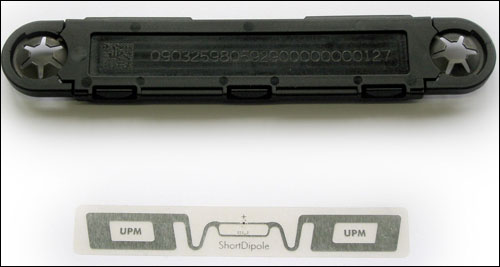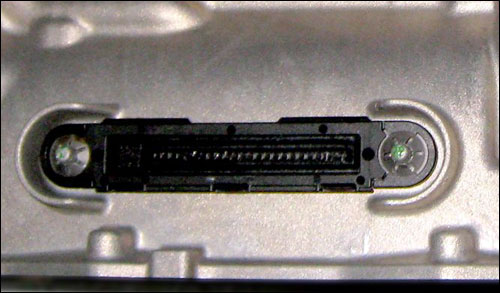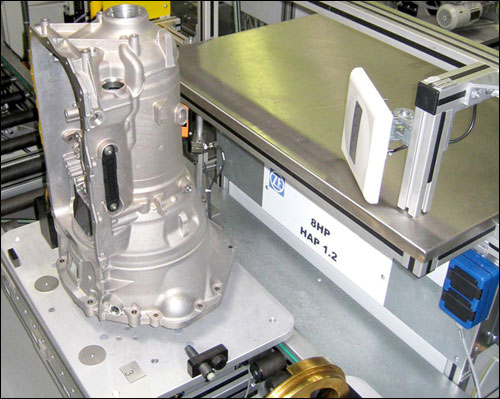ZF Friedrichshafen, a supplier of automotive components to major vehicle manufacturers, has expanded its use of radio frequency identification, by adding a system that tracks and guides the production of eight-speed transmissions at the company’s plant in Saarbrücken, Germany.
During the past three years, the firm gained experience with RFID by using the technology to track shipments (see RFID Helps ZF Speed Transmission Shipments), as well the maintenance history of motors used to operate its assembly line (see RFID Helps ZF Friedrichshafen Maintain Factory Infrastructure).
For the new project, ZF designed a new production process specifically with RFID in mind. The company required a method of identifying each transmission it produces, and had had bad experiences with bar-coded labels, because they often became damaged or fell off during production. After testing RFID tags to make sure they could withstand ZF’s harsh industrial environment, the firm implemented RFID technology directly into its production process, creating a factory line to manufacture eight-speed transmissions, that includes roughly 15 points at which RFID tags are identified and information used to control the production process is saved on the tags.
When a transmission housing is cast by ZF or one of its suppliers, the object is fitted with a UPM Raflatac ShortDipole passive ultrahigh-frequency (UHF) RFID inlay embedded within a protective plastic casing. The inlay, which complies with the EPC Gen 2 standard, has 512 bits of user memory, which ZF encodes with production-related data, says Gerhard Schaller, the company’s manager of information technology and factory automation for car driveline technology. Such information includes the article number, the serial number, the date the gearbox was cast and the production machines on which it was made.
Once the tags are applied, ZF or its supplier employs RFID interrogators—both handheld and fixed—to test the tags and store casting information on them. The supplier then sends the transmission housings to ZF, where the latter interrogates the tags in order to identify the transmission housings, which it then moves onto the production line.
Along the production line, ZF identifies the housing approximately 15 times during three production phases: mechanical processing, gearbox assembly and gearbox inspection, according to Jürgen Kusper, a business solution manager at B&M Tricon Auto-ID Solutions, an Austria-based business that served as the project’s planner and integrator. Kusper described the project at the RFID Journal LIVE! Europe 2009 conference, held earlier this year near Frankfurt.
At multiple points along the fully automated production line, ZF interrogates the tags using either a long-range reader or a read-write station. At each point, the system reads the tags and may retrieve information from them that can change the course of production for particular transmission units. For instance, processing parameters and measurements may be used for custom production. At the read-write stations, the system updates data encoded to the tag, such as adding production status information.
“The entire production process is controlled by RFID,” Kusper says.
In the final phase of production, each transmission is filled with oil and given a test run, to ensure that it functions properly. Once the transmission passes this test, the system then encodes the item’s serial number to the RFID tag, and some production information remains on the tag for the purpose of diagnostics and process monitoring. The remainder of the production data remains on ZF’s servers for tracking purposes, in the event of a problem.
The system was implemented in early 2009 and reached mass production by September. ZF expects to manufacture 100,000 to 200,000 transmissions each year using the RFID-controlled production line.
The main benefits of the system, Kusper says, are reliable, low-cost and unique identification of gearboxes, as well as the ability to control production with data saved on the tags.
“ZF is using RFID to reduce interface complexity in its production,” Kusper states. “The RFID tags help to connect production machines to each other.”
The system is based on middleware called You-R OPEN, provided by RF-IT Solutions, located in Graz, Austria. ZF already utilizes the software for another application, and can administer it centrally. The software’s Control Logic function integrates Siemens‘ RF 660 readers into the system. ZF also uses a limited number of Psion Teklogix Workabout Pro handheld interrogators for ad-hoc readings of gearbox tags.
ZF expects to use the tagged gearboxes as the basis for further RFID applications, for itself or for its partners. It could utilize the tags in its own logistics processes, for instance, or automakers could read the tags during their vehicle-assembly processes. Furthermore, auto repair shops could employ the tags to identify the transmissions, and to store maintenance and inspection data on them.






